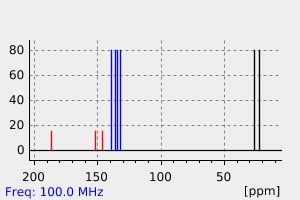2,6-dimethylcyclohepta-2,4,6-trien-1-one | 499197-98-7
中文名称
——
中文别名
——
英文名称
2,6-dimethylcyclohepta-2,4,6-trien-1-one
英文别名
2,6-dimethyltropone;2,6-Dimethyl-2,4,6-cycloheptatrien-1-one
CAS
499197-98-7
化学式
C9H10O
mdl
——
分子量
134.178
InChiKey
XYMJWVXKLXVOJW-UHFFFAOYSA-N
BEILSTEIN
——
EINECS
——
-
物化性质
-
计算性质
-
ADMET
-
安全信息
-
SDS
-
制备方法与用途
-
上下游信息
-
文献信息
-
表征谱图
-
同类化合物
-
相关功能分类
-
相关结构分类
物化性质
-
沸点:236.7±7.0 °C(Predicted)
-
密度:0.982±0.06 g/cm3(Predicted)
计算性质
-
辛醇/水分配系数(LogP):1.9
-
重原子数:10
-
可旋转键数:0
-
环数:1.0
-
sp3杂化的碳原子比例:0.22
-
拓扑面积:17.1
-
氢给体数:0
-
氢受体数:1
反应信息
-
作为反应物:描述:diiron nonacarbonyl 、 2,6-dimethylcyclohepta-2,4,6-trien-1-one 以 苯 为溶剂, 以66%的产率得到tricarbonyl[(4,5,6,7)-η-2,6-dimethyltropone]iron参考文献:名称:与2-甲基和2,6-二甲基对苯二铁三羰基配合物的通量行为相关的热力学和动力学参数摘要:为三羰基的2-甲基-和2,6-二甲基衍生物的regioisomerisation的动力学和热力学参数[η 4 -tropone]铁络合物进行了研究,由1个1 H NMR光谱在一定范围的40℃。这些复合物通过分子内的一阶过程进行和结果在较稳定的复合物(的几乎完全转化的Regioisomerisation 4, 8),以更稳定的区域异构体(1, 5)。发现转化(4 → 1)和(8 → 5)的活化能和半衰期为ΔG # = 92 kJ mol -1; τ1 /2= 12.8h,ΔG #= 107kJ mol -1。分别在23°C时τ1 /2 = 26.8 h。配合物1与(1R,2S,5R)-薄荷醇在硫酸溶液中反应,然后用碳酸钠中和,得到非对映体三羰基[(2,3,4,5-η)-(1R ',2S )的可分离混合物′,5R ′)-6-薄荷基氧基-2-甲基对苯二酮]铁配合物,9和10。相应的二甲基化络合物5在这些条件下不能反应。DOI:10.1016/j.jorganchem.2003.11.039
-
作为产物:描述:4-bromo-2-chloro-3,7-dimethylcyclohept-2-ene-1-one 在 lithium carbonate 作用下, 以 N,N-二甲基甲酰胺 为溶剂, 反应 0.75h, 以69%的产率得到2,6-dimethylcyclohepta-2,4,6-trien-1-one参考文献:名称:2,6-二甲基环己酮的合成 - 一种新的、方便的 2,6-二甲基环己酮方法摘要:到目前为止,尚未描述 2,6-二烷基托烷。2,6-二甲基托酮 (5) 代表了合成天然抗病毒化合物的合适材料。开发了一种新的、方便的方法,用于通过 5 个优化步骤从 2,6-二甲基环己酮合成 2,6-二甲基托酮 (5),总产率为 52%。由 2,6-二甲基环己-1-酮制备的三甲基甲硅烷基烯醇醚 1 用二氯卡宾处理,得到 7,7-二氯-2,6-二甲基-1-三甲基甲硅烷氧基双环[4.1.0]庚烷 (2)。在室温下,酸促进 2 的开环得到 2-chloro-3,7-dimethylcyclohept-2-ene-1-one (3a)。在较高温度 (150-300 °C) 下,分别以 2.1:1,0 的比例获得 3a 和 2-氯-3,7-二甲基-1-三甲基甲硅烷氧基环庚-1,3-drene (3b) 的混合物。NBS/AIBN 对 3a 进行伽马溴化反应得到比例为 5:1 的非对映异构体 4a 和 4b,在DOI:10.1055/s-2002-33709
表征谱图
-
氢谱1HNMR
-
质谱MS
-
碳谱13CNMR
-
红外IR
-
拉曼Raman
-
峰位数据
-
峰位匹配
-
表征信息
同类化合物
脱羰秋水仙碱
红陪酚四甲基醚
红倍酚
秋水仙碱甲硫代磺酸盐
秋水仙碱
硫代秋水仙碱
甲基丙烯酸7-氧代-4-(苯基偶氮)-1,3,5-环庚三烯-1-基酯
甲基6-肼基-7-氧代-1,3,5-环庚三烯-1-羧酸酯
环庚三烯酮
环庚三烯酚酮
氨甲酸,(1-乙基戊基)-,甲基酯(9CI)
桧木醇
异秋水仙胺
尼楚酮
对二硫辛酸
双环[4.4.1]十一碳-1(10),2,4,6,8-五烯-11-酮
双环[4.1.0]庚-1,3,5-三烯-7-酮
去乙酰氨基秋水仙碱
原秋水仙碱
十四烷酸,4-(十八烷氧基)-7-羰基-1,3,5-环庚三烯-1-基酯
乙基[(7S)-1,2,3,10-四甲氧基-9-氧代-5,6,7,9-四氢苯并[a]庚搭烯-7-基]氨基甲酸酯
三甲基秋水仙素酸
三甲基秋水仙素酸
三(2-羟基-2,4,6-环庚三烯-1-酮)-铟
α-(异丙基)-γ,γ-二甲基环己丙醇
beta-斧松素
[(7S)-7-乙酰氨基-1,3-二甲氧基-10-甲硫基-9-氧代-6,7-二氢-5H-苯并[d]庚搭烯-2-基]2-氯乙酸酯
[(7S)-7-乙酰氨基-1,2-二甲氧基-10-甲硫基-9-氧代-6,7-二氢-5H-苯并[d]庚搭烯-3-基]2-氯乙酸酯
N-(2-巯基乙基)秋水仙胺
N-脱乙酰基3-去甲基硫代秋水仙碱
N-脱乙酰基,1,2,3,10-脱甲基秋水仙碱
N-甲酰脱乙酰秋水仙碱
N-甲酰基秋水仙胺
N-甲基-秋水仙碱
N-三氟乙酰基-N-甲基-去乙酰基秋水仙碱
N-[(S)-5,6,7,9-四氢-1,2,3,10-四甲氧基-9-氧代苯并[a]庚搭烯-7-基]-2,2,2-三氟乙酰胺
N-[(7S)-4-(羟基甲基)-1,2,3,10-四甲氧基-9-氧代-6,7-二氢-5H-苯并[d]庚搭烯-7-基]乙酰胺
N-[(7S)-10-(丁基氨基)-5,6,7,9-四氢-1,2,3-三甲氧基-9-氧代苯并[a]庚搭烯-7-基]-乙酰胺
N-[(7S)-1,2,3-三甲氧基-9-氧代-10-(苯基甲硫基)-6,7-二氢-5H-苯并[d]庚搭烯-7-基]乙酰胺
N-[(7S)-1,2,3-三甲氧基-9-氧代-10-(苯基甲基氨基)-6,7-二氢-5H-苯并[d]庚搭烯-7-基]乙酰胺
N-[(7S)-1,2,3,10-四甲氧基-9-氧代-5,6,7,9-四氢苯并[a]庚搭烯-7-基]丙酰胺
N-[(7R)-1,2,3,10-四甲氧基-9-氧代-6,7-二氢-5H-苯并[d]庚搭烯-7-基]乙酰胺
N-(乙氧基乙酰基)去乙酰基硫代秋水仙碱
N-(5,6,7,9-四氢-1,2,3-三甲氧基-10-甲硫基-9-氧代苯并[a]庚搭烯-7-基)氨基甲酸乙酯
N-(4-甲酰基-1,2,3,10-四甲氧基-9-氧代-6,7-二氢-5H-苯并[d]庚搭烯-7-基)乙酰胺
N-(10-二甲基氨基-1,2,3-三甲氧基-9-氧代-6,7-二氢-5H-苯并[d]庚搭烯-7-基)乙酰胺
N-(1,2,3,9-四甲氧基-10-氧代-6,7-二氢-5H-苯并[d]庚搭烯-7-基)乙酰胺
N-(1,2,3,10-四甲氧基-9-氧代-5,6,7,9-四氢苯并[a]庚搭烯-7-基)乙酰胺
9H-三苯并[A,C,E][7]环轮烯-9-酮
8H-环庚三烯并[c]异噻唑-8-酮,3-甲基-







